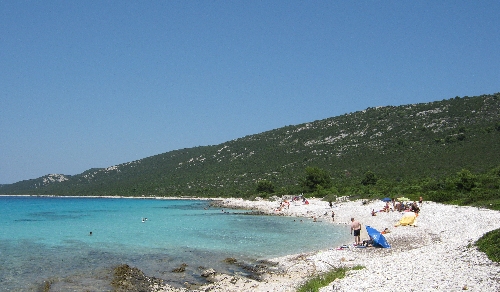
As elsewhere in Croatia, what is called ‘the beach’ on Dugi Otok isn’t what one normally would think of as a beach. There are no long stretches of sand gently sloping down into the sea. Instead, in each of the island’s coastal settlements, there are man-made places where it is possible to enter the sea and swim and sunbathe on the shore.

The two pictures on the left are of our nearest ‘beach’ in Sali, about ten minutes walk from the apartment. They illustrate what I mean by ‘the beach’ being man-made. The handrails do make entering the sea that bit easier and the sea itself was very pleasantly warm. However, there is no chance to gently wade in as the sea-bottom drops away quite steeply. This part of ‘the beach’ is quite shaded but the pier provides plenty of space for sun worshippers.
Similar ‘beaches’ to this can be found in all the island settlements along the sheltered east coast of Dugi Otok. There are no settlements at all on the more exposed west coast. But in a couple of places, a steep minor road leaves the main north-south road and descends to the shore. One leads to a place called Mala Voda which literally translates as ‘little water’. I say ‘place’ but there are no buildings other than a wooden shack – just an area for car parking together with a tiny harbour where small boats can be launched.

It is then possible to walk 300-400 metres north from the car park, either along the pebbly shoreline or on a parallel path through the ‘maquis’ and reach a place that more resembles what I understand as a beach! Whilst the area above sea level is made up entirely of pebbles, as soon as one enters the sea there is sand under foot. And here it is possible to gently wade some way into the sea before being out of one’s depth.

Mala Voda became our favourite beach during our ten days on Dugi Otok. It was never crowded, no doubt because it takes a little more effort to reach it, and always felt very relaxed. In many respects it is the perfect beach for children as access to the sea is so much easier than on the man-made ‘beaches’. But we saw very few children almost certainly because of the greater effort needed to reach the beach. It has no shade so we always took our beach umbrella and often went in the late afternoon when the angle of the sun was lower.
If we return to Dugi Otok sometime in the future, which I hope we will, one thing I shall certainly look forward to doing is swimming in the sea again from the beach at Mala Voda.



Without being a Croatian linguist, I’m sure that ‘mala’ means small/little just as in Czech. Admittedly there can be some ‘false friends’ among Slavonic languages, such as the word ‘záchod’ which means WC in Czech but sunset in Russian. Gerry
Gerry – Thank you for pointing out my stupidity. I’ve now corrected the post. Mala is small/little in Croatian as I ordered a Mala Pivo once when I was driving & got a 0.3 one rather than a 0.5.
Were you able to visit the beach at Saharun? It is located near the village of Soline.
Hi Natalie – Welcome to my blog.
We did walk down from the main road to the beach bar at one end of Saharun/Sakarun beach late one afternoon when we explored the very northern end of Dugi Otok. However, we didn’t swim there as, most unusually during our time on the island, the weather had just turned cooler and cloudier.
Most publicity about Saharun/Sakarun beach describes it as the only sandy beach on the island. From what we saw on our brief visit, it is rather like Mala Voda with the beach consisting of pebbles but being sandy underfoot as soon as you enter the sea. It obviously gets quite busy during the height of the summer season as there were quite a lot of people on the beach when we visited, even though the weather was beginning to turn cooler.